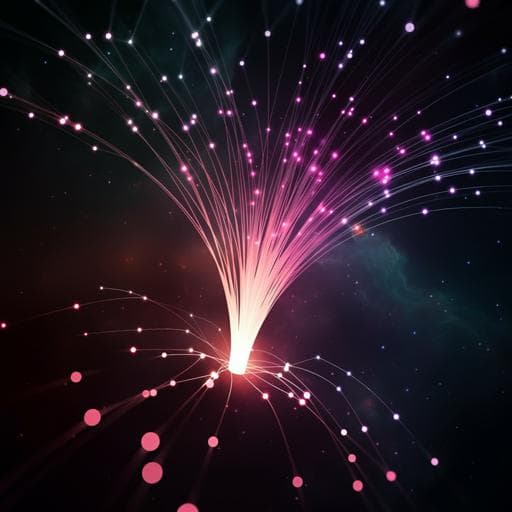
Physics
Two-photon comb with wavelength conversion and 20-km distribution for quantum communication
K. Niizeki, D. Yoshida, et al.
This study highlights a groundbreaking source of entanglement in the telecom band, achieving impressive fidelity and narrow linewidth, even over long fiber distances. Conducted by Kazuya Niizeki and colleagues, this research paves the way for efficient entanglement distribution in quantum communications.
~3 min • Beginner • English
Introduction
The study addresses the challenge of long-distance quantum communication over optical fibers, where loss prevents direct amplification of unknown quantum states and necessitates quantum repeaters. While satellite links have demonstrated very long-distance quantum links, fiber networks offer stability and existing infrastructure. The authors aim to develop a quantum-memory-compatible, telecom-wavelength entanglement source with narrow linewidth and high fidelity to support quantum internet applications such as teleportation, entanglement swapping, and distributed/secure cloud quantum computing. They target combining a telecom-band source suitable for low-loss fiber transmission with wavelength conversion to visible wavelengths compatible with solid-state quantum memories (e.g., Pr3+:YSO), while maintaining high entanglement quality and narrow spectral features across many frequency modes for multiplexing.
Literature Review
Prior work includes demonstrations of quantum supremacy processors, satellite-based entanglement and QKD over thousands of kilometers, and theoretical limits on fiber QKD distance without repeaters (~550 km) with best experimental records (~421 km). Quantum repeaters with and without memories have been proposed and demonstrated in parts. Cavity-enhanced SPDC sources have been used for narrow-linewidth, bright single-mode, and multimode photon generation, including sub-MHz sources. Wavelength conversion has been demonstrated with lasers and single photons to interface telecom photons with various quantum systems (NV centers, rare-earth doped crystals, quantum dots, rubidium). However, realizing simultaneously high count rates, sub-10 MHz linewidths, and high entanglement fidelity at telecom wavelengths remains challenging. The authors build on polarization-entangled generation using orthogonal PPLN crystals and cavity enhancement, and on SFG-based wavelength conversion to 606 nm for Pr3+:YSO memories.
Methodology
- Two-photon comb (TPC) source: Degenerate SPDC at 1514 nm in a bow-tie cavity (~2.5 m length, FSR ~116–120 MHz) containing two mutually orthogonal type-0 PPLN crystals (dimensions 0.5×3×10 mm and 0.5×0.5×10 mm; Jinan Institute of Quantum Technology). Crystals and holders were temperature stabilized to within ~1 mK. The SPDC pump at 757 nm was generated by SHG of a 1514-nm external cavity diode laser (Sacher TEC420-1530-1000) stabilized to acetylene. The pump was focused to ~25 µm waist using lenses and a plano-concave mirror. Cavity locking employed Pound-Drever-Hall (PDH) with an optical chopper (duty cycle 1/3) to stabilize both the cavity resonance to the QM target frequency and the entangled-state relative phase.
- Polarization entanglement: Orthogonal PPLN arrangement produced |α|HH⟩ + β|VV⟩ states with adjustable amplitudes via pump polarization (HWP). Advantages include higher brightness, reduced alignment sensitivity, and compensated birefringence-induced phase.
- Characterization: Two-photon statistics measured using a Hanbury-Brown–Twiss setup with a 50:50 beam splitter, two SSPDs (≈85% efficiency at telecom; ~40 ps jitter), and a TCSPC module (HydraHarp 400; 32 ps resolution for extended windows, 16 ps elsewhere). Tomography used a 50:50 beam splitter and polarization analyzers (1514-nm QWP, HWP, vertical polarizer) with SSPDs; maximum-likelihood reconstruction over 16 settings. Bell states formed by inserting additional HWPs after the beam splitter (one as phase shifter via yaw angle, one as bit-flip with slow axis at 45°). Typical per-basis integration 15 s, total ~10 min per set.
- Fiber distribution: After coupling to single-mode fiber, photons transmitted over 10 km fiber (telecom), yielding total pair separation of 20 km after splitting. Fiber dispersion used to estimate comb bandwidth.
- Wavelength conversion (WC): Telecom photons combined with an auxiliary laser at 1010 nm (TOPTICA TA pro stabilized via iodine) and coupled into a type-0 PPLN waveguide (NTT Electronics; 9.9×11 µm cross-section, 48 mm length). SFG to 606 nm (Pr3+:YSO transition 3H4(0)→1D2(0)) targeted. Coupling efficiencies ~60% for both beams; internal conversion efficiency ~96%, external ~60%. Spectral filtering used two dichroic mirrors and one bandpass filter to suppress SPDC, Raman, residual pump leaks, and stray light. Converted photons detected with Si APDs (~60% efficiency; ~300 ps jitter). Measurements conducted with/without 10-km fiber before WC. Normalized second-order signal-idler correlation coefficient g^(2)(0) extracted as peak-to-noise ratio.
- Additional parameters: Output coupler reflectivities of 99% and 95% were used to trade linewidth against escape/brightness. Cavity comb and envelope analyzed to extract FSR, coherence time, and linewidth. Fiber transmittance at 1514 nm measured ~62%.
Key Findings
- Comb structure and linewidth: Two-photon correlation shows periodic peaks at 8.6 ns intervals corresponding to FSR ≈116–120 MHz. The exponential envelope yields a cavity linewidth Δν ≈0.95 MHz with 99% output mirror (degenerate photon linewidth ~0.61 MHz), and 1.35 MHz with 95% mirror (higher brightness).
- Coherence and bandwidth: Coherence time up to ~1 µs observed. Fiber-dispersion analysis after 10 km indicates comb spectral range of ~1–2 THz.
- Entanglement quality: Tomography (95% mirror) gives maximal fidelity to an arbitrary pure state of 96.1% and concurrence of 93.0%; CHSH S = 2.47 (>2 indicates nonlocality). Bell-state fidelities: |Φ+⟩ 90.0%, |Φ−⟩ 90.2%, |Ψ+⟩ 89.4%, |Ψ−⟩ 88.1%.
- Wavelength conversion performance: External SFG conversion efficiency ~60% (internal ~96%). WC bandwidth limited by phase matching to ~25 GHz. Despite bandwidth mismatch to TPC (~1 THz), clear WC two-photon comb (WC-TPC) observed.
- Correlation after distribution and conversion: After 10-km fiber transmission (total separation 20 km) and WC, clear two-photon comb with normalized second-order correlation g^(2)(0) ≈3 observed with Si APDs despite larger timing jitter. Telecom-only one-photon-to-visible correlation was not clearly observed (g^(2)(0)≈1) due to uncorrelated multi-pair noise.
- SNR behavior: g^(2)(0) versus SPDC pump power indicates that g^(2)(0) after WC can exceed that before WC due to a correlation-filtering effect, selecting highly correlated spectral-temporal modes around degeneracy within WC bandwidth. Fiber transmittance at 1514 nm measured ≈62%.
Discussion
The TPC source delivers a unique combination of very narrow sub-MHz linewidth with a wide multi-THz comb and high-fidelity polarization entanglement, well suited for atomic-frequency-comb quantum memories. Its long cavity length provides narrow linewidth even at moderate finesse, reducing sensitivity to alignment drift while maintaining compatibility with QM absorption windows (e.g., Pr3+:YSO ~4.6 MHz). Environmental stabilization (temperature at millikelvin levels, airflow isolation) is essential to maintain phase coherence across many modes; additional compensation crystals and dual-cavity approaches could further improve stability and fidelity.
Wavelength conversion to 606 nm via SFG preserves temporal/linewidth profiles and enables interfacing with Pr3+:YSO memories. The observed increase in g^(2)(0) post-WC stems from selecting correlated photon pairs within the WC spectral acceptance (frequency-domain filtering around degeneracy) and from temporal selection that suppresses multi-pair noise within the SPDC coherence time. However, single-photon WC correlations were obscured by multi-pair background at telecom.
Bandwidth mismatch (TPC ~1 THz vs WC ~25 GHz) attenuates usable modes but still yields adequate SNR. Tailored spectral filtering focused on the WC-TPC spectrum—potentially using high-dopant (~1%) Pr3+:YSO as a dynamic bandpass filter—could further suppress out-of-band WC noise. Addressing polarization sensitivity of the current WC (via polarization-insensitive WC designs) would mitigate fiber-induced polarization rotations, though at possible efficiency costs. Employing time-bin qubits is recommended for robust fiber transmission and compatibility with single-polarization WC. Overall, the results support frequency- and time-multiplexed long-distance entanglement distribution compatible with solid-state quantum memories.
Conclusion
The authors demonstrate a versatile entanglement source in the telecom band that generates a two-photon comb with sub-MHz linewidth, high entanglement fidelity (up to 96.1% for pure-state overlap; ~90% for Bell states), and multimode capacity. They achieve two-photon distribution over 20 km (10 km per arm) in fiber followed by wavelength conversion to 606 nm, observing clear two-photon correlations with g^(2)(0) ≈3 despite detector jitter and WC bandwidth limits. This establishes a practical path toward memory-compatible, frequency-multiplexed quantum networking.
Future work includes: specialized noise filters matched to the TPC spectrum (e.g., high-dopant Pr3+:YSO dynamic filters), polarization-insensitive WC, Bell-state measurements in multimode regimes for multiplexed quantum communication, and conversion from polarization to time-bin encoding to evaluate full system performance including basis-conversion losses.
Limitations
- WC bandwidth (~25 GHz) is much narrower than the TPC comb (~1–2 THz), limiting simultaneous mode utilization and contributing to loss outside the acceptance band.
- Current WC is polarization sensitive, making performance susceptible to fiber-induced polarization rotation; active stabilization or polarization-insensitive WC would be needed in practical links.
- Single-photon WC correlations were not observable (g^(2)(0)≈1) due to multi-pair noise at telecom, indicating the need for improved filtering and lower pump powers for heralded operation.
- Entanglement fidelities for explicit Bell states are ~88–90%, affected by waveplate dispersion/retardance and multi-mode effects; environmental sensitivity (temperature, air convection) can degrade phase stability.
- Fiber losses (measured ~62% transmittance over 10 km at 1514 nm including connections) and detector timing jitter in the visible limit g^(2)(0) and coincidence rates.
- No storage in a quantum memory was demonstrated; the interface was validated via wavelength conversion and correlation only.
Related Publications
Explore these studies to deepen your understanding of the subject.







